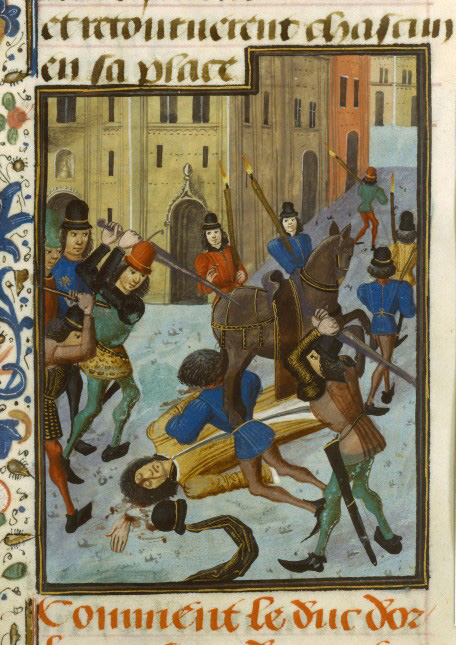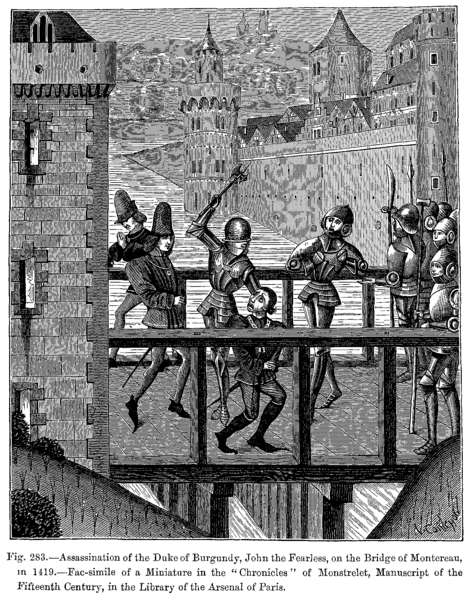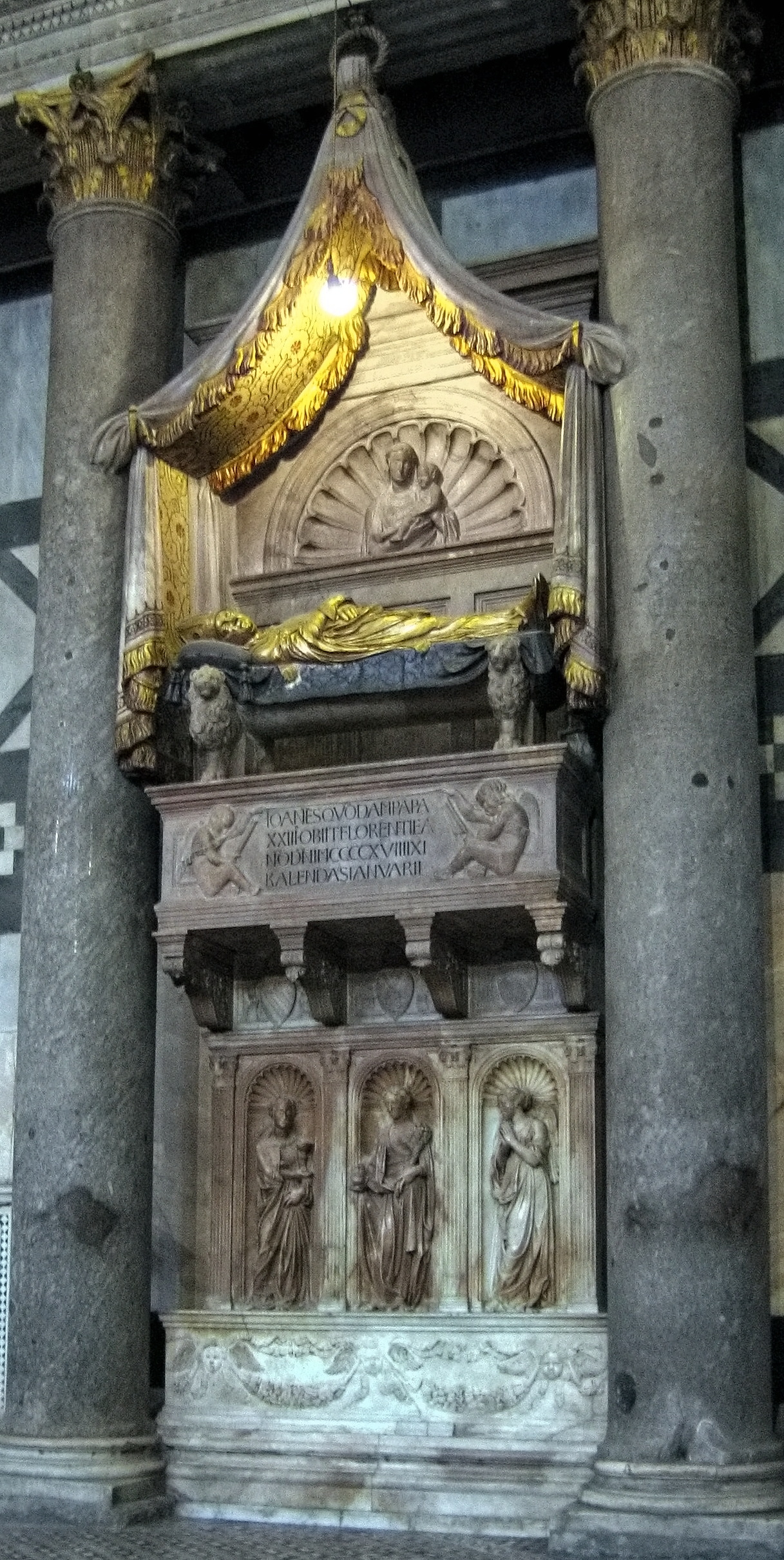|
Jean Petit (theologian)
Jean Petit (Jehan Petit, John Parvus) (b. most likely at Brachy, Caux, in Normandy, and certainly in the Diocese of Rouen, c. 1360 − 15 July 1411) was a French theologian and professor in the University of Paris. He is known for his public defence of a political killing as tyrannicide. Life Some historians ( Duboulay, Luke Wadding) say he was a Franciscan, others that he was a Dominican: as a matter of fact, he never was a member of any religious order. He owed his education to the generosity of the Duke of Burgundy, who granted him a pension. In the first extant document that records his name, he is called Master of Arts (16 August 1385). Two years later his name occurs in the list sent by the University of Paris (31 July 1387) to Pope Clement VII, recommending its masters for vacant benefices. He became a licentiate in theology in May 1400, and received the degree of Doctor before 1403, since he is mentioned in that year on the roll of the university as an active member of ... [...More Info...] [...Related Items...] OR: [Wikipedia] [Google] [Baidu] |
Brachy
Brachy () is a commune in the Seine-Maritime department in the Normandy region in northern France. Geography A farming village situated by the banks of the river Saâne in the Pays de Caux, some southwest of Dieppe, at the junction of the D4, D108 and the D152 roads. Population Places of interest * Two ancient manorhouses. * The church of St. Martin, dating from the twelfth century. * The seventeenth century church of St. Ouen. * The church of St. Remy, at Gourel, dating from the eleventh century. * A stone cross from the fifteenth century. See also *Communes of the Seine-Maritime department The following is a list of the 708 communes of the French department of Seine-Maritime. The communes cooperate in the following intercommunalities (as of 2020): [...More Info...] [...Related Items...] OR: [Wikipedia] [Google] [Baidu] |
John The Fearless
John I (french: Jean sans Peur; nl, Jan zonder Vrees; 28 May 137110 September 1419) was a scion of the French royal family who ruled the Burgundian State from 1404 until his death in 1419. He played a key role in French national affairs during the early 15th century, particularly in the struggles to rule the country for the mentally ill King Charles VI, his cousin, and the Hundred Years' War with England. A rash, ruthless and unscrupulous politician, John murdered the King's brother, the Duke of Orléans, in an attempt to gain control of the government, which led to the eruption of the Armagnac–Burgundian Civil War in France and in turn culminated in his own assassination in 1419. The involvement of Charles, the heir to the French throne, in his assassination prompted John's son and successor Philip to seek an alliance with the English, thereby bringing the Hundred Years' War to its final phase. John played an important role in the development of gunpowder artillery in E ... [...More Info...] [...Related Items...] OR: [Wikipedia] [Google] [Baidu] |
Emperor Sigismund
Sigismund of Luxembourg (15 February 1368 – 9 December 1437) was a monarch as King of Hungary and Croatia ('' jure uxoris'') from 1387, King of Germany from 1410, King of Bohemia from 1419, and Holy Roman Emperor from 1433 until his death in 1437, as well as prince-elector of Brandenburg (1378–1388 and 1411–1415). He was the last male member of the House of Luxembourg. Sigismund was the son of Holy Roman Emperor Charles IV and his fourth wife Elizabeth of Pomerania. He married Queen Mary of Hungary in 1385 and was crowned King of Hungary soon after. He fought to restore and maintain authority to the throne. Mary died in 1395, leaving Sigismund the sole ruler of Hungary. In 1396, Sigismund led the Crusade of Nicopolis, but was decisively defeated by the Ottoman Empire. Afterwards, he founded the Order of the Dragon to fight the Turks and secured the thrones of Croatia, Germany and Bohemia. Sigismund was one of the driving forces behind the Council of Constance (1414� ... [...More Info...] [...Related Items...] OR: [Wikipedia] [Google] [Baidu] |
Treaty Of Arras (1415) (January 1579), the pledge of loyalty to Spain by the Southern Netherlands
{{disambig ...
There have been several treaties of Arras: * Treaty of Arras (1435), between Charles VII of France and Philip the Good of Burgundy * Treaty of Arras (1482), between Louis XI of France and the governments of the Low Countries * Treaty of Arras (1579), signed in May 1579 * Union of Arras The Union of Arras (Dutch: ''Unie van Atrecht'', French: ''Union d'Arras'', Spanish: ''Unión de Arrás'') was an alliance between the County of Artois, the County of Hainaut and the city of Douai in the Habsburg Netherlands in early 1579 during ... [...More Info...] [...Related Items...] OR: [Wikipedia] [Google] [Baidu] |
Konstanz
Konstanz (, , locally: ; also written as Constance in English) is a university city with approximately 83,000 inhabitants located at the western end of Lake Constance in the south of Germany. The city houses the University of Konstanz and was the residence of the Roman Catholic Diocese of Konstanz for more than 1,200 years. Location The city is located in the state of Baden-Württemberg and situated at the banks of Lake Constance (''Bodensee'' in German). The river Rhine, which starts in the Swiss Alps, passes through Lake Constance and leaves it, considerably larger, by flowing under a bridge connecting the two parts of the city. North of the river lies the larger part of the city with residential areas, industrial estates, and the University of Konstanz; while south of the river is the old town, which houses the administrative centre and shopping facilities in addition to the ''Hochschule'' or the ''University of Applied Sciences''. Car ferries provide access across Lake Con ... [...More Info...] [...Related Items...] OR: [Wikipedia] [Google] [Baidu] |
Council Of Constance
The Council of Constance was a 15th-century ecumenical council recognized by the Catholic Church, held from 1414 to 1418 in the Bishopric of Constance in present-day Germany. The council ended the Western Schism by deposing or accepting the resignation of the remaining papal claimants and by electing Pope Martin V. It was the last papal election to take place outside of Italy. The council also condemned Jan Hus as a heretic and facilitated his execution by the civil authority, and ruled on issues of national sovereignty, the rights of pagans and just war, in response to a conflict between the Grand Duchy of Lithuania, Kingdom of Poland and the Order of the Teutonic Knights. The council is also important for its relationship to ecclesial conciliarism and Papal supremacy. The council's decrees were formally annulled by Pope Sixtus IV in 1478. Origin and background The council's main purpose was to end the Papal schism which had resulted from the confusion following the Avig ... [...More Info...] [...Related Items...] OR: [Wikipedia] [Google] [Baidu] |
Antipope John XXIII
Baldassarre Cossa (c. 1370 – 22 December 1419) was Pisan antipope John XXIII (1410–1415) during the Western Schism. The Catholic Church regards him as an antipope, as he opposed Pope Gregory XII whom the Catholic Church now recognizes as the rightful successor of Saint Peter. He was also an opponent of Antipope Benedict XIII, who was recognized by the French clergy and monarchy as the legitimate Pontiff. Cossa was born in the Kingdom of Naples. In 1403, he served as a papal legate in Romagna. He participated in the Council of Pisa in 1408, which sought to end the Western Schism with the election of a third alternative pope. In 1410, he succeeded Antipope Alexander V, taking the name John XXIII. At the instigation of Sigismund, King of the Romans, Pope John called the Council of Constance of 1413, which deposed John XXIII and Benedict XIII, accepted Gregory XII's resignation, and elected Pope Martin V to replace them, thus ending the schism. John XXIII was tried fo ... [...More Info...] [...Related Items...] OR: [Wikipedia] [Google] [Baidu] |
Bishop Of Paris
The Archdiocese of Paris (Latin: ''Archidioecesis Parisiensis''; French: ''Archidiocèse de Paris'') is a Latin Church ecclesiastical jurisdiction or archdiocese of the Catholic Church in France. It is one of twenty-three archdioceses in France. The original diocese is traditionally thought to have been created in the 3rd century by St. Denis and corresponded with the Civitas Parisiorum; it was elevated to an archdiocese on October 20, 1622. Before that date the bishops were suffragan to the archbishops of Sens. History Its suffragan dioceses, created in 1966 and encompassing the Île-de-France region, are Créteil, Evry-Corbeil-Essonnes, Meaux, Nanterre, Pontoise, Saint-Denis, and Versailles. Its liturgical centre is at Notre-Dame Cathedral in Paris. The archbishop resides on rue Barbet de Jouy in the 6th arrondissement, but there are diocesan offices in rue de la Ville-Eveque, rue St. Bernard and in other areas of the city. The archbishop is ordinary for Eastern Cathol ... [...More Info...] [...Related Items...] OR: [Wikipedia] [Google] [Baidu] |
Gerard De Montaigu
Gerard is a masculine forename of Proto-Germanic origin, variations of which exist in many Germanic and Romance languages. Like many other early Germanic names, it is dithematic, consisting of two meaningful constituents put together. In this case, those constituents are ''gari'' > ''ger-'' (meaning 'spear') and -''hard'' (meaning 'hard/strong/brave'). Common forms of the name are Gerard (English, Scottish, Irish, Dutch, Polish and Catalan); Gerrard (English, Scottish, Irish); Gerardo (Italian, and Spanish); Geraldo (Portuguese); Gherardo (Italian); Gherardi (Northern Italian, now only a surname); Gérard (variant forms ''Girard'' and ''Guérard'', now only surnames, French); Gearóid (Irish); Gerhardt and Gerhart/Gerhard/Gerhardus (German, Dutch, and Afrikaans); Gellért ( Hungarian); Gerardas ( Lithuanian) and Gerards/Ģirts ( Latvian); Γεράρδης (Greece). A few abbreviated forms are Gerry and Jerry (English); Gerd (German) and Gert (Afrikaans and Dutch); Gerrit (A ... [...More Info...] [...Related Items...] OR: [Wikipedia] [Google] [Baidu] |
Jean Gerson
Jean Charlier de Gerson (13 December 1363 – 12 July 1429) was a French scholar, educator, reformer, and poet, Chancellor of the University of Paris, a guiding light of the conciliar movement and one of the most prominent theologians at the Council of Constance. He was one of the first thinkers to develop what would later come to be called natural rights theory, and was also one of the first individuals to defend Joan of Arc and proclaim her supernatural vocation as authentic.Richard Tuck, ''Philosophy and Government 1572-1651'' (1993), pp. 25-7. Aged fourteen, he left Gerson-lès-Barby to study at the college of Navarre in Paris under Gilles Deschamps, ( Aegidius Campensis) and Pierre d'Ailly (''Petrus de Alliaco''), who became his life-long friend. Early life and education Gerson was born at Gerson-lès-Barby, Gerson (paroisse de Barby) a hamlet in the present municipality of Barby, Ardennes in the bishopric of Reims in Champagne. His parents, Arnulphe Charlier and Éli ... [...More Info...] [...Related Items...] OR: [Wikipedia] [Google] [Baidu] |
Artois
Artois ( ; ; nl, Artesië; English adjective: ''Artesian'') is a region of northern France. Its territory covers an area of about 4,000 km2 and it has a population of about one million. Its principal cities are Arras (Dutch: ''Atrecht''), Saint-Omer, Lens, and Béthune. It is the eponym for the term '' artesian''. Location Artois occupies the interior of the Pas-de-Calais ''département'',"Artois" in ''The New Encyclopædia Britannica''. Chicago: Encyclopædia Britannica Inc., 15th ed., 1992, Vol. 1, p. 607. the western part of which constitutes the former Boulonnais. Artois roughly corresponds to the arrondissements of Arras, Béthune, Saint Omer, and Lens, and the eastern part of the arrondissement of Montreuil. It occupies the western end of the coalfield which stretches eastward through the neighbouring Nord ''département'' and across central Belgium. History Originally a feudal county itself, Artois was annexed by the county of Flanders. It came to France in ... [...More Info...] [...Related Items...] OR: [Wikipedia] [Google] [Baidu] |
Hesdin
Hesdin (; vls, Heusdin) is a commune in the Pas-de-Calais department in northern France. Geography The N39, from Arras to Montreuil, used to be the main thoroughfare of the town. In the 1950s, a circular route was created to help traffic flow. A second bypass was built in the 1980s, taking all through traffic well away from the town centre. The Canche river flows through the centre of Hesdin. History Hesdin was a fief of the counts of Artois, vassals of the Counts of Flanders until 1180. When Philip, count of Flanders gave Artois as dowry to his niece Isabella of Hainault when she married Philip Augustus of France in 1180, Hesdin and the other seigneuries passed to France. At the end of the 11th century, Hesdin gained renown for the park and chateau of Robert II, Count of Artois, which featured the earliest examples of early medieval automata in Europe. These included mechanical monkeys covered in badger fur, mechanized fountains, a large sundial surrounded by lions and l ... [...More Info...] [...Related Items...] OR: [Wikipedia] [Google] [Baidu] |


.jpg)




